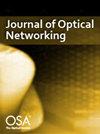Reconfigurable encoder-decoder structure for 2D OCDMA systems
引用次数: 1
Abstract
We propose and experimentally demonstrate a 2.5Gbits/s reconfigurable encoder-decoder structure that can be used for two-dimensional (time-wavelength) optical code-division multiple access (OCDMA) systems. Each encoder and decoder is constructed using a single opto-very-large-scale-integrated (VLSI) processor for encoding N users, thus eliminating the need for optical switching between encoders. The opto-VLSI processor synthesizes wavelength codewords through computer-generated digital phase holograms, which can switch the wavelength through different true-time-delay paths. The encoded signal can be successfully retrieved at the decoder side only when the digital phase holograms of the encoder and the decoder are matched. The system performance is measured in terms of the generated autocorrelation and cross-correlation functions as well as eye diagrams.二维OCDMA系统的可重构编解码器结构
我们提出并实验证明了一种可用于二维(时间波长)光码分多址(OCDMA)系统的2.5Gbits/s可重构编码器-解码器结构。每个编码器和解码器都使用单个光超大规模集成(VLSI)处理器构建,用于编码N个用户,从而消除了编码器之间光切换的需要。光vlsi处理器通过计算机生成的数字相位全息图合成波长码字,可以通过不同的真时延路径切换波长。只有当编码器和解码器的数字相位全息图匹配时,才能在解码器侧成功检索编码信号。系统性能是根据生成的自相关和互相关函数以及眼图来衡量的。
本文章由计算机程序翻译,如有差异,请以英文原文为准。
求助全文
约1分钟内获得全文
求助全文

 求助内容:
求助内容: 应助结果提醒方式:
应助结果提醒方式:


